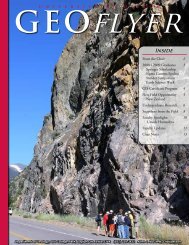Stander Symposium abstract book - University of Dayton
Stander Symposium abstract book - University of Dayton
Stander Symposium abstract book - University of Dayton
You also want an ePaper? Increase the reach of your titles
YUMPU automatically turns print PDFs into web optimized ePapers that Google loves.
9:00 AM to 10:30 AM<br />
Novel Concepts for Spring-Based Mechanical Energy Storage in Motor Vehicles<br />
Presenter(s): Jonathan W Lauden<br />
Advisor(s): Andrew P Murray, David H Myszka<br />
Mechanical and Aerospace Engineering - Graduate Research<br />
Vehicle systems that store and retrieve energy have commonly relied on lead-acid or lithium-ion batteries as a storage medium. Springs are an<br />
alternative means <strong>of</strong> energy storage and could be used to supplement batteries in such systems. This would allow a reduction in the size <strong>of</strong> those<br />
batteries and the electric motors they operate, potentially accompanied with financial and environmental benefits. The general properties <strong>of</strong><br />
springs suggest that they are well-suited for use in motor vehicle systems. Springs are able to provide a large amount <strong>of</strong> power relative to their<br />
size, and have the ability to store potential mechanical energy in a context where mechanical energy is required. In contrast, electrical energy-storage<br />
systems require additional motors and generators to apply or absorb mechanical energy. This research explores the utility <strong>of</strong> spring materials<br />
in automotive systems through the design and construction <strong>of</strong> a prototypical spring-based engine-starting system. The objectives are threefold:<br />
to determine the physical properties <strong>of</strong> several elastomers to assess their potential as energy-storage media, to derive the operating requirements<br />
and ideal size <strong>of</strong> a starting system from a production engine, and to design and build a prototype that is physically able to meet or exceed those<br />
operating requirements. Having accomplished these three objectives, the feasibility <strong>of</strong> using springs for other energy-storage systems may be<br />
explored, as well as the potential for large-scale production <strong>of</strong> such a system.<br />
Rehabilitation Engineering: Design <strong>of</strong> a Shower Transfer Seat<br />
Presenter(s): Rachael A Johanek, Alexander P Jules, Deborah M Kinor, Kendra M Rindler, Julia M Schaeffer,<br />
Erin E Sutton<br />
Advisor(s): Kimberly E Bigelow<br />
Mechanical and Aerospace Engineering - Independent Research<br />
The Engineering Wellness and Safety Lab (EWSL), directed by Dr. Kimberly Bigelow, gives undergraduate and graduate students the opportunity<br />
to perform biomechanical engineering research. This semester, the research team has partnered with the Kettering Health Network and NeuroRehab<br />
and Balance Center to design a handicapped-accessible shower transfer seat, a need identified by occupational therapists. After researching<br />
many current shower seats and collaborating with occupational therapists and shower seat users, the EWSL developed a list <strong>of</strong> design requirements.<br />
These requirements will be incorporated in each <strong>of</strong> our designs: an adjustable peri-care door, adjustable legs with a large range <strong>of</strong> heights,<br />
corrosion resistant materials, mildew and mold resistant materials, adjustable for right and left shower heads, proper drainage in the seat and<br />
legs, backrest, supports 350 pounds, weighs less than 10 pounds, does not allow water to leak out <strong>of</strong> the shower, and costs less than 150 dollars for<br />
the user. The lab also created a list <strong>of</strong> design criteria which will us to choose the best design. The design criteria for this project are: safe, adjustable,<br />
compatible with curtain, durable, low effort, easy to remove, comfortable, intuitive, space efficient, accessories within reach, and easy to clean.<br />
The design requirements and criteria will be used to develop an appropriate design to test. The final functional prototype will be presented to the<br />
Kettering Health Network and the NeuroRehab and Balance Center at the end <strong>of</strong> this semester.<br />
The Effect <strong>of</strong> Different Foams on Posturography Measures in Healthy and Impaired<br />
Populations<br />
Presenter(s): Daniel J Petit<br />
Advisor(s): Kimberly E Bigelow<br />
Mechanical and Aerospace Engineering - Graduate Research<br />
The manipulation <strong>of</strong> available sensory inputs is an important component in static posturography testing to examine one’s multisensory reweighting<br />
ability and to identify potential balance problems that would otherwise be masked by compensation. Traditionally, to reduce the availability <strong>of</strong><br />
proprioceptive input, subjects are asked to stand barefoot on a foam pad placed on top <strong>of</strong> the force platform. However, the choice <strong>of</strong> what kind <strong>of</strong><br />
foam block to use <strong>of</strong>ten falls on the shoulders <strong>of</strong> the investigator or clinician as it is rarely well defined in testing procedures. While previous studies<br />
have investigated the effect <strong>of</strong> varying foam types on outcome measures, it has not been well investigated whether choice <strong>of</strong> foam influences<br />
the ability to differentiate between healthy and impaired populations using posturography. Anterior-posterior (A/P) and medial-lateral center <strong>of</strong><br />
pressure displacement data was collected using a 3-component force plate. Each trial lasted 30 seconds with a sampling rate <strong>of</strong> 1000Hz. For this<br />
72

















